PFM Crown: Alloys Used, Advantages, and Potential Limitations
PFM (Porcelain-Fused-to-Metal) crowns are considered a reliable and commonly used dental restoration due to their durability and natural aesthetics. Their structure consists of a metal substructure layered with porcelain, which closely mimics the appearance of natural teeth. These crowns offer acceptable biocompatibility, promoting periodontal health. The metal framework can be made from non-precious, semi-precious, or high-noble alloys.
What is a PFM Crown?
PFM (Porcelain-Fused-to-Metal) crowns are dual-layer restorations, consisting of a metal substructure covered by an outer layer of porcelain. Combining two materials, PFM crowns offer a balanced solution between full metal restorations and all-ceramic crowns. The metal core enhances strength and longevity, while the porcelain coating provides a natural tooth-like appearance, making them a popular choice among patients.
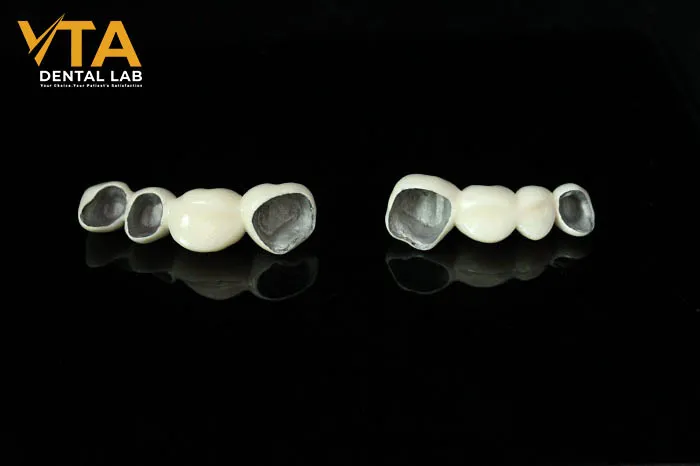
PFM crown has porcelain on the outside
Alloys Used in the Fabrication of PFM Crown
The alloys used for Porcelain-Fused-to-Metal (PFM) restorations are typically classified into three main categories: high noble, noble (semi-precious), and base (non-precious) metals.
- High-Noble Alloys
High noble alloys contain more than 60% noble metals, with at least 40% being gold. These may include elements such as gold (Au), platinum (Pt), palladium (Pd), indium (In), silver (Ag), and gallium (Ga). The color of these alloys ranges from yellow to white or silver, depending on the composition.
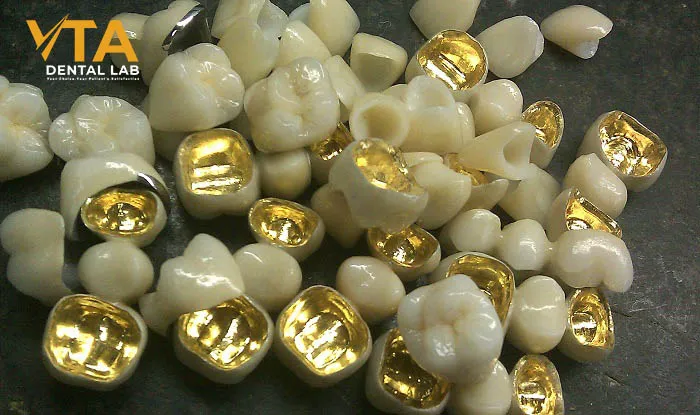
Both metal and porcelain are highly durable materials, able to withstand chewing stress and years of use
- Noble (Semi-Precious) Alloys
These contain at least 25% noble metals and may include tin (Sn), zinc (Zn), indium (In), cobalt (Co), or gallium (Ga). Semi-precious PFM restorations usually appear white or silver.
- Base (Non-Precious) Alloys
Also referred to as basic alloys, these contain less than 25% noble metals, and in some cases, none. Instead, they are primarily composed of chromium (Cr), cobalt (Co), nickel (Ni), and beryllium (Be). Other commonly found elements include tungsten (W), manganese (Mn), iron (Fe), silicon (Si), carbon (C), and molybdenum (Mo). These alloys typically exhibit a silver appearance.
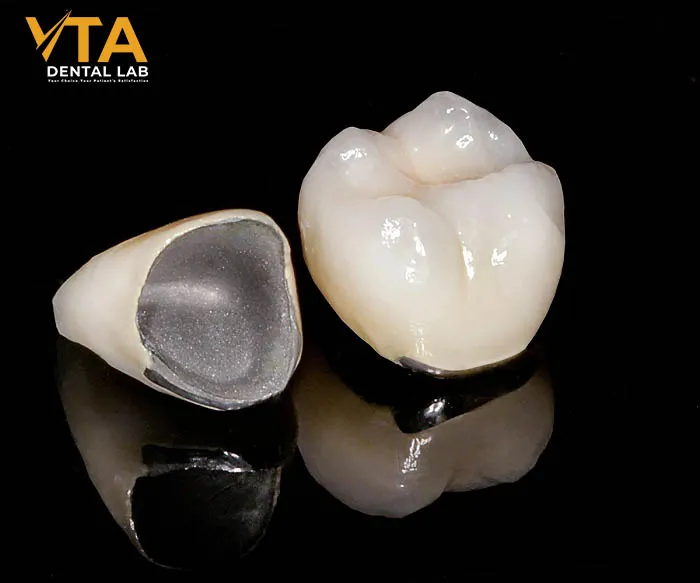
Porcelain-fused-to-metal (PFM) crowns have been considered the gold standard for the repair of damaged teeth
The exact composition of the alloy used for PFM crowns may vary depending on the dental laboratory. At VTA, we always provide our partners with a detailed list of the elements and their respective percentages for each alloy, ensuring that the most suitable restorative option can be selected based on the patient’s specific clinical and aesthetic needs.
When to Choose Porcelain-Fused-to-Metal (PFM) Restorations
Porcelain-Fused-to-Metal (PFM) crowns are a popular restorative choice due to their combination of metal’s mechanical strength and the aesthetic appeal of a porcelain overlay. PFM is especially suitable for posterior restorations or less visible areas within the smile zone, where high masticatory forces must be managed while still maintaining a reasonable level of aesthetics.
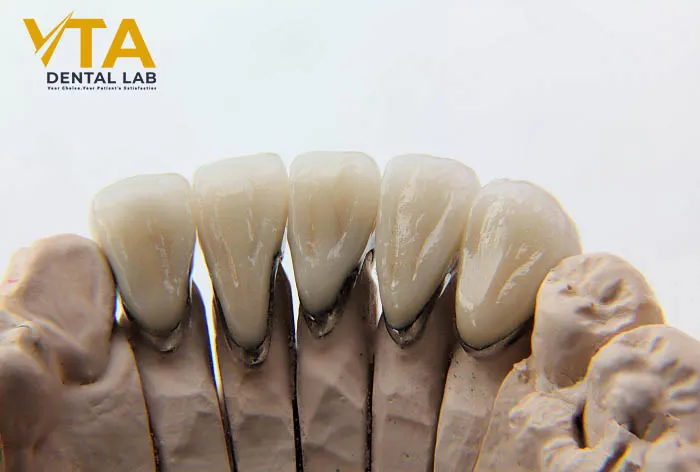
PFM is the preferred choice for long-lasting bridges, especially when night grinding is an issue
This type of restoration is also ideal for long-span bridges or multi-unit prostheses, as the metal framework provides enhanced stability and resistance to fracture compared to all-ceramic alternatives.
PFM crowns are frequently indicated for patients with bruxism or strong bite forces, thanks to their high durability and reduced risk of chipping. They are also widely used in implant-supported restorations due to their technical versatility and high precision during placement.
For patients with moderate budgets, PFM offers a cost-effective solution that ensures long-term function with acceptable aesthetic results.
Potential Limitations of Choosing PFM Crowns
Despite the many advantages of Porcelain-Fused-to-Metal (PFM) crowns, there are some inherent limitations to consider. One common concern is the appearance of a dark line at the gum margin, especially in anterior restorations. This becomes more noticeable if the patient’s gums recede over time. To improve aesthetics in such cases, a porcelain margin can be used to help maintain a more natural-looking smile.

PFM crown looks like your natural teeth
Another consideration is that PFM crowns can appear somewhat opaque, lacking the translucency and brightness of natural enamel or all-ceramic restorations. This is due to the fact that while light can pass through the outer porcelain layer, it cannot penetrate the underlying metal substructure. As a result, when placed next to all-ceramic crowns, PFMs may not achieve a perfect shade match.
Gingival sensitivity and biocompatibility issues are also important, particularly when using non-precious alloys. Some patients may experience gum irritation, which can contribute to long-term gingival recession. While high-noble metal PFMs offer better tissue compatibility and reduced risk of irritation, they tend to be more expensive due to fluctuating gold prices. For patients with metal sensitivities or high aesthetic demands, all-ceramic options, such as Full Solid Zirconia or High Translucency (HT) Zirconia, may be more appropriate alternatives.
Guidelines for PFM Crown Tooth Preparation
Proper tooth preparation is critical for the long-term success of Porcelain-Fused-to-Metal (PFM) crowns. Due to their dual-layer structure, adequate reduction is required, especially to ensure the porcelain layer has enough thickness to mask the underlying metal substructure and achieve a natural level of translucency. Precision and adherence to clinical guidelines are key for ensuring optimal crown fit and function.
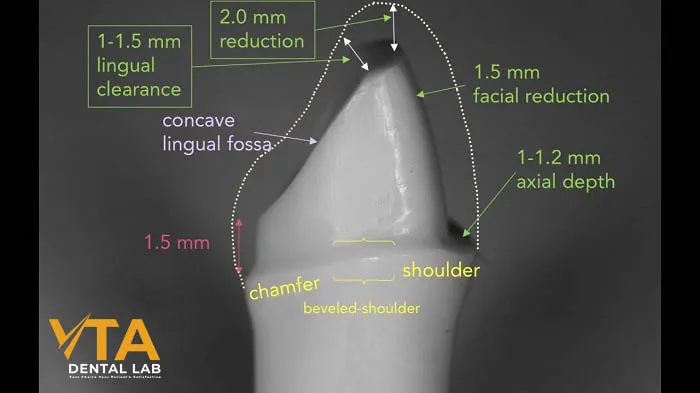
Guidelines for PFM Crown Tooth Preparation
Key Steps in PFM Crown Preparation
- Depth Orientation Grooves (Occlusal/Incisal): Depth grooves help guide uniform reduction and control the amount of tooth structure being removed.
- Facial/ Buccal Reduction: Reduce approximately 1.2–1.5 mm to provide adequate space for the porcelain on the facial surface of anterior teeth or the buccal surface of posterior teeth.
- Lingual and Proximal Reduction: The lingual surface should be reduced by about 1 mm, while the incisal or occlusal edge requires around 2 mm of reduction to accommodate sufficient porcelain thickness and natural translucency.
- Finish Line Design (Shoulder or Chamfer): A well-defined shoulder or deep chamfer finish line of around 1 mm should be created, extending interproximally to support the porcelain and improve marginal fit.

Tooth preparation should always be customized based on the location of the restoration. PFM crowns have been a clinically successful solution for decades, offering both durability and esthetic outcomes when properly executed.
If you have any questions or need professional support in selecting the right materials or techniques, don’t hesitate to contact our experienced technicians at VTA Dental Lab. We’re always here to assist you with case-specific recommendations and personalized solutions.